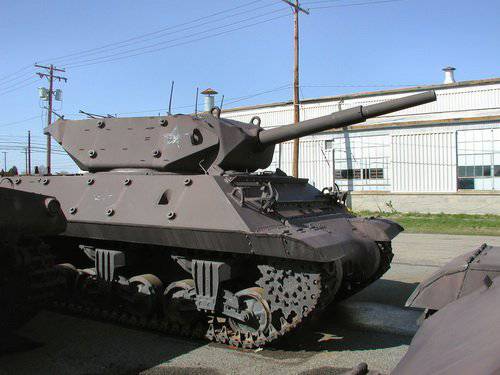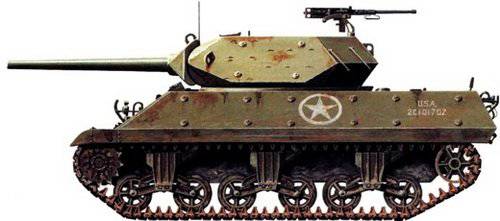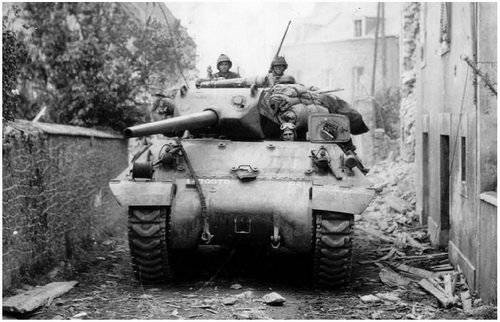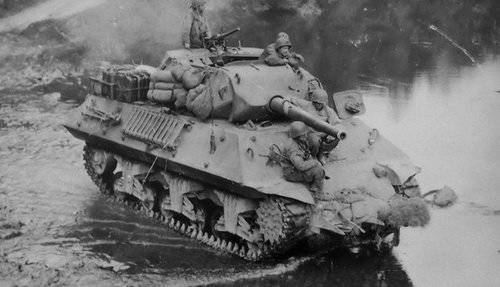American PT-ACS times of war (part 1) - M10 Wolverine
Unlike the German and Soviet self-propelled guns of the Second World War, in American self-propelled guns the gun was installed not in an armored armchair, but in a rotating turret, as well as on tanks. The 10-inch (3 mm) M76,2 cannon was used to equip the M-7 ACS, which was located in an open top tower. At the stern, a special counterweight was mounted, which gave the tower a distinctive and easily recognizable silhouette. For combat against armored targets, a caliber armor-piercing projectile without a M79 ballistic tip was used. This projectile at a distance of 1000 yards (900 m) at an angle of meeting 30 ° relative to the normal pierced 76 mm of armor. Full ammunition SAU consisted of 54 shells. For self-defense and repel air attacks, the self-propelled gun was equipped with an 12,7-mm Browning submachine gun M2, which was installed at the stern of the turret. Ammunition machine gun consisted of 300 cartridges, in addition to this, the crew had for self-defense and personal weapon.
History create
By the beginning of the Second World War, the American Army was conducting emergency work at creating and adopting the 2-x tank destroyers — the M3 and the M6. At the same time, both cars were only a forced temporary measure and were poorly suited to combat tanks. The army needed a full-fledged self-propelled artillery gun - tank destroyer. The development of such a machine in the United States began in November 1941 year. The project provided for installation of the gun on the base of the M4А1 tank with a cast hull and a gasoline engine, but in December 1941 this project was revised in favor of another modification of the Sherman tank М4А2, which differed from the previous version with a welded body and a diesel engine.

The prototype of the ACS was named T35. In January, a wooden model was made for 1942, followed by the assembly of the first PT-ACS in the metal. At the same time, the hull of the M4А2 tank underwent a number of changes - the machine lost its course machine gun, the thickness of the frontal armor remained the same, and from the sides it was reduced to 1 inches. Reservations in the transmission area were further strengthened by overlays from 2's armor plates, which were welded at an angle of 90 degrees. The 76,2-mm gun was installed in a round open turret, which was borrowed from the prototype heavy tank T1.
In the midst of work on the T35, the military put forward new requirements - sloping body armor and a low silhouette of the car. The designers presented the 3 different versions of the ACS, of which one was chosen to receive the index Т35Е1. The new version of the machine was based on the chassis of the M4А2 tank, the thickness of the armor decreased, there were additional slopes at the superstructure; instead of a round tower, a tower was installed from the M35. In January, 1942, the Chisler Tank Division of the Fisher company, began work on two prototypes of the T35-1. Both cars were ready for the spring 1942 of the year. Their tests proved the advantage of the inclined hull armor, but the cast tower of the ACS evoked complaints from the military. In this regard, it was decided to develop a new tower, which was made in the shape of a hexagon, welded from rolled armor plates.

The tests of the T35EX1 ACS were completed in May 1942. The machine was recommended for production after eliminating a number of minor comments to the design.
- The military demanded to reduce the reservation, for the sake of greater speed. The American concept of PT-ACS suggested that speed is more useful than good body protection.
- Make a hatch to accommodate the driver.
- The differential should cover armor not from 3-x parts, but from one.
- The possibility of installing additional armor on the forehead and sides of the hull, as well as the tower, must be realized.
Standardized and improved PT-ACS Т35Е1 in June 1942 was sent to production under the designation М10. The crew of the car consisted of 5 people: the commander of the ACS (located on the right in the tower), the gunner (in the tower on the left), loader (in the tower behind), the driver (in front of the hull on the left) and the assistant driver (in the front of the hull on right). Despite the desire of the military as soon as possible to start the release of the M10, they had serious difficulties with the design of the hexagonal tower. In order not to postpone the release, a temporary pentahedral tower was made, which went into series. As a result, all the destroyers of the M10 tanks were manufactured with her, and it was decided to abandon the hexagon tower. It is also worth noting one drawback that the M10 Wolverine ACS had. The hatches of the driver and his assistant, it was impossible to open at that moment when the gun was directed forward, the mask of the gun interfered with the opening of the hatches.
The main weapon of the SAU was the 3-inch inch 76,2-mm gun M7, which had a good rate of fire - 15 shots per minute. Angles in the vertical plane ranged from -10 to + 30 degrees, in the horizontal - 360 degrees. Ammunition PT-ACS consisted of 54 shots. 6 combat shots were placed in two packs (3 each) on the back wall of the tower. The rest of the 48 shots were in special fiber containers in 4 stacks in sponsons. Statewide, the ammunition should consist of 90% armor-piercing shells and 10% high-explosive. Also, it could include smoke projectiles and canister.

Combat application
The M10 ACS was produced from the 1942 to the end of the 1943 of the year and, above all, entered into service with the tank fighter battalions (with the 54 ACS in each). The American combat doctrine suggested the use of tank destroyers to destroy enemy tanks, while our own tanks were to be used to support infantry units in combat. The M10 Wolverine became the most massive anti-tank ACS of the American army during World War II. The combat debut of the PT-SAU occurred in North Africa and was quite successful, as its three-inch gun could hit most German tanks operating in this theater of operations without any problems from long distances. At the same time, the low-speed and heavy chassis did not conform to the doctrine adopted in the USA, according to which faster and easier self-propelled guns were to be used as tank destroyers. Therefore, already at the beginning of 1944, in parts of the PT-ACS M10, they began to be replaced with more lightly armored and high-speed ACS M18 Hellcat.
Serious tests fell on the M10 ACS during the landing in Normandy and the subsequent battles. Due to the fact that the M10 possessed a more or less anti-tank 76,2-mm gun, they were actively attracted to fight with German tanks. I quickly found out that the M10 could not successfully fight the new German tanks, the Panther, the Tiger, and even more so the Royal Tigers. Part of the Lend-Lease self-propelled gun data was given to the British, who quickly abandoned the American low-power 76-mm gun and replaced it with their 17-pound gun. The English version of the M10 is called Achilles I and Achilles II. In the autumn of 1944, these installations began to be replaced with more advanced MX -UMX Jackson PT-ACS. At the same time, the remaining M36 continued to be used until the end of the war.
About 54 data self-propelled guns were sent to the USSR under Lend-Lease, but nothing is known about their use in the Red Army. Also, these machines received and combat units of the army "Free France". One of these machines, called the Scirocco, which was under the control of French sailors, became famous for knocking out the Panther on Place de la Concorde in Paris in the last days of the Paris uprising.

Combat experience has shown that the M10 self-propelled turret open at the top makes the vehicle very vulnerable to artillery and mortar fire, as well as to infantry attacks, especially during combat in forest and urban environments. So even the most ordinary hand grenade could easily disable the self-propelled gun crew. Booking self-propelled guns also caused complaints, as it could not withstand the German anti-tank guns. But the biggest drawback was the very low speed of rotation of the tower. This process was not mechanized and was performed manually. It took at least 2 minutes to make a full revolution. Also, contrary to the accepted doctrine, American PT-ACS consumed more high-explosive fragmentation projectiles than armor-piercing shells. Most often, self-propelled guns played the role of tanks on the battlefield, although on paper they were supposed to support them.
In the best way, the M10 Wolverine showed themselves in defensive battles, where they were significantly superior to towed anti-tank guns. They were successfully used during the Arden operation. The battalions armed with the PT-SAU M10 proved to be 5-6 times more effective than the units armed with towed anti-tank guns of the same caliber. In cases where the M10 reinforced the defenses of the infantry units, the ratio of losses and victories was 1: 6 in favor of the PT-ACS. It was in the battles in the Ardens that self-propelled guns, despite all their shortcomings, demonstrated how superior they are to towed artillery, from that moment on the American army began an active process of rearming anti-tank battalions for self-propelled guns.
Performance characteristics: M10 Wolverine
Mass: 29,5 t.
Dimensions:
Length 6,828 m., Width 3,05 m., Height 2,896 m.
Crew: 5 people.
Reservations: from 19 to 57 mm.
Armament: 76,2-mm M7 rifled gun
Ammunition: 54 projectile
Engine: two-row 12 cylinder diesel liquid cooling hp power 375
Maximum speed: on the highway - 48 km / h
Power reserve: on the highway - 320 km.
Information